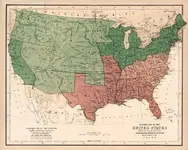Bigcypresshunter
Sapphire Member
- Joined
- Dec 15, 2004
- Messages
- 27,000
- Reaction score
- 3,340
- Golden Thread
- 0
- Location
- South Florida
- Detector(s) used
- 70's Whites TM Amphibian, HH Pulse, Ace 250
- Primary Interest:
- Beach & Shallow Water Hunting
Yes very good Mr. O. This appears to be the same story. I dont know about the dates. There seems to be several different versions of it or maybe there is another missing shipment.Oroblanco said:HOLA amigos,
Is this the story we are researching?
quote
KGC GOLD IN THE EVERGLADES
In 1862, under the auspices of a hot Florida sun, Confederate Major Thomas Reynolds was on the run from Union troops. His mission was simple enough, get a shipment of gold coins estimated to be nearly $200,000 worth to a secret location near Jupiter Lighthouse, where a Confederate blockade runner waited to transport the hoard for shipment to banks in Europe. This gold was from members of the secretive Knights of the Golden Circle in Ohio.
To avoid capture, Major Reynolds reached Lake Okeechobee and decided to head South. He and his men found a small village in the Everglades, about 30 miles South of the lake, where a group of Baptists from South Carolina had established a sugar plantation in the 1830's. Figuring this was a safe spot, Major Reynolds instructed his men to bury the chest of gold coins for safekeeping.
For one reason or another, the chest of gold was never recovered. Shortly after World World 2, a pilot flying over the Everglades about 30 miles West of Fort Lauderdale spotted an island where banana trees were growing, something highly unusual for this area. He led a small party who rented an airboat and spent the next 3 weeks combing the region, recovering a number of CSA rifles, canteens, bullet molds and other misc Confederate military equipment.
Most treasure experts say this is the location where Major Reynolds buried the Knights of the Golden Circle chest of gold coins. Some have even suggested that the cache may have been divided and buried between 2 islands at this location. But, would they have had time to do this? I feel if they buried the cache here on this island and knowing full well that Union troops were scounting nearby for them, Major Reynolds would of only used one location. Using logical sense would make the difference. If they had returned to salvage the chest of coins I don't feel Major Reynolds would of spent the extra time digging in two spots when he could of just dug in one.
There are numerous accounts of treasure being stored or lost in the Everglades and one smart treasure hunter with a sense of direction could probley find this island and the original location of the sugar plantation. Who knows what else may be hidden there? Only the alligators and snakes know for sure and I doubt they are going to provide any answers!
by By Randy Sumpter ( Offering FREE research help ! )
RIO77@MVN.NET
unquote
I presume this is the story? If it is, we have enough info to determine if it is truth or bogus now. Let me know if this is the same story, and thank you in advance,
Oroblanco






 I am hoping it was not just a band of deserters on that island. I have received more clues in the past month than I have in the past 35 years. I remember reading about this cache as a child in the library and I xeroxed the page and kept it all these years in a box with other treasure related newsclippings.
I am hoping it was not just a band of deserters on that island. I have received more clues in the past month than I have in the past 35 years. I remember reading about this cache as a child in the library and I xeroxed the page and kept it all these years in a box with other treasure related newsclippings.




 as a reward for their service) while in florida jackson fought anyone he ran across that didn't give in to him --it showed how very weak the spanish really were and later on lead to spain basically giving up florida to the US. -- in exchange for the USA covering up to 5 million dollars worth of losses that americans claimed against spain for failing to control / stop the raiders in "their" land from attacking americans and their "property"
as a reward for their service) while in florida jackson fought anyone he ran across that didn't give in to him --it showed how very weak the spanish really were and later on lead to spain basically giving up florida to the US. -- in exchange for the USA covering up to 5 million dollars worth of losses that americans claimed against spain for failing to control / stop the raiders in "their" land from attacking americans and their "property"
